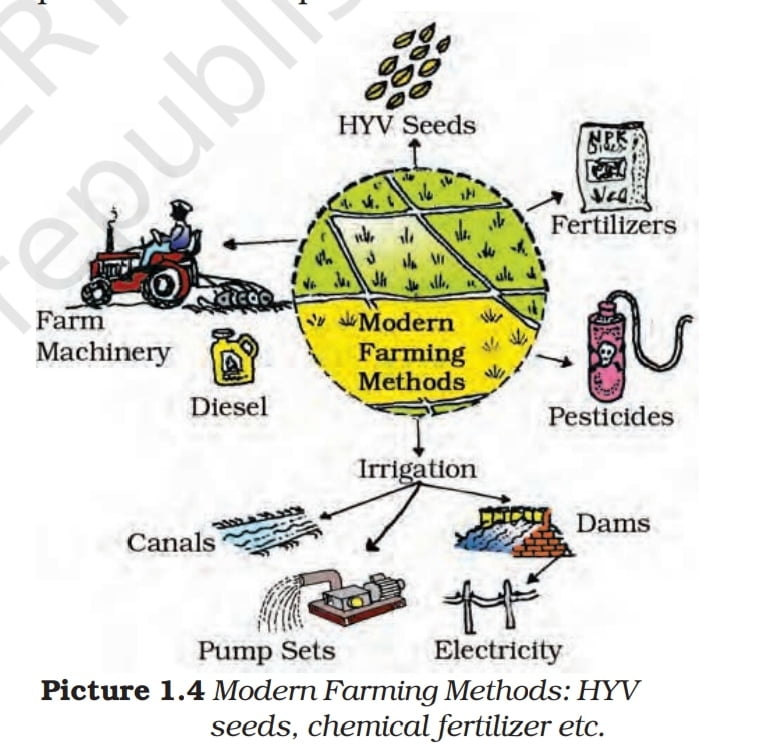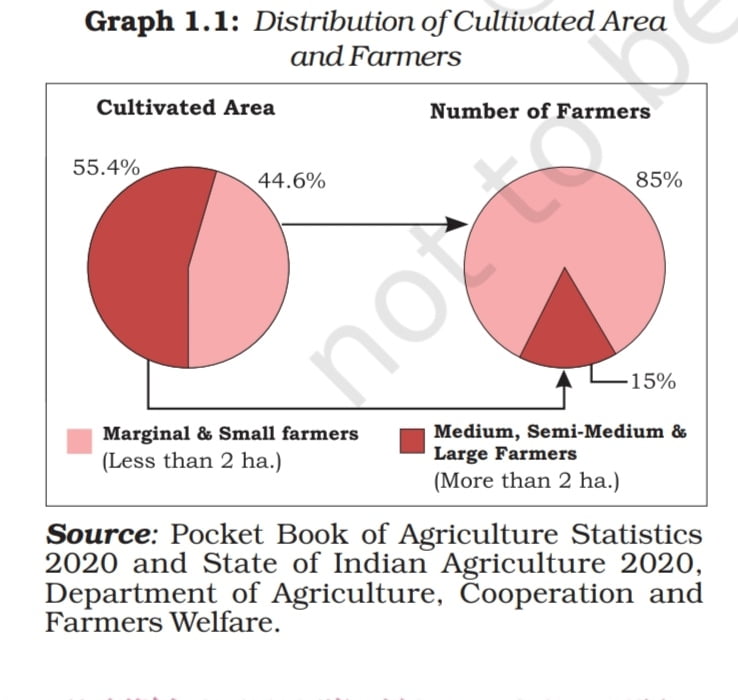Class 9 Economics Chapter 1 The story of Village Palampur Notes
class 9 Economics Chapter 1 The Story of Village Palampur notes deals with many economic concepts that are important for proper understanding of the economic system. It discusses about the type of economic activity and methods of farming.
Introduction
Palampur is a hypothetical village that is well developed in various aspects. It has well connected roads, transportation, one public schools, private dispensary, government primary health centres and is connected to towns for the availability of various things required for consumption. Almost 450 families of different castes live here in which 80% are high castes and other includes lower castes like scheduled caste.
Organisation of Production
Production is a complex process in which various inputs are arranged like land, labour and capital to produce output or product and services that human wants so production is organized by the arrangement of four factors of production.
- The first is land and other natural resources such as water, forest and minerals
- The second is labour which are of various types like unskilled, semi skilled and skilled . It depends on industry which kind of labour is required.
- Third is physical capital which is subdivided into fixed and working capital
- . Fixed capital – Tools,machines, buildings which are purchased and sustain for long period of time like 10 to 15 years are fixed capital and are essential base for production.
- Working Capital- Production requires raw materials and money in hand to keep production process running and can be used to make payment for the purchasing of materials. It is used to increase production so that supply can be maintained according to demand.
- Fourth is human capital and enterprise who put together land, labour and physical capital with his skills and knowledge.
- So every production is organised by combining land, labour, physical capital and human capital which are known as factors of production.
Land
Land is a fixed natural resources means it can neither be added or substracted which provides livelihood to almost 75% people who are directly or indirectly dependent on farming. As we all know population is increasing day by day but not land . Now the question arise how production can be increased with limited land. It can be increaed either wastelands is converted into farmlands or by adopting different methods of farming.
There are two methods which are adopted to increase farm production to maintain the food requirement which are given below-Methods to increase production
1. Multicropping– When two or more crops are grown on a same piece of land during a year is known as multicropping.
2. Modern farming methods– When farming is done with HYVs seeds, fertilizers, chemical, pesticides and good good irrigation system that increase yield of a fieldf manifold.
Earlier, farming was done with traditional seeds, cow dung and other natural manure that gave less yield. The green revolution of 1960s introduced the farmers to cultivation of wheat and rice using HYVs (modern farming methods) that was tried first by the farmers if Punjab, Haryana and Western Uttar Pradesh that gave more field and generated a large surplus of production of wheat and rice.

Instead of traditional and simple tools, farmers bought modern farm machinery like tractors, combine, machines etc that made work simple and fast. In an agricultural year, different crops are grown in different different season that are listed below.
There are mainly two seasons- kharif and Rabi
1.Kharif – This season starts with the onset of monsoon means July when crops are sown like jowar, bajra, paddy and cotton etc. and harvested in October.
2.Rabi– This crop season generally starts with November ( winter season) in which wheat, mustard, potatoes are sown and harvested either in March and April.
A part of land is used in sugarcane production
- Zaid– It is a short period of cultivation in which cucumber, melon, watermelon, and other vegetables are grown between April to june.
The main reason to grow three different crops in a year is due to well developed irrigation system which made possible for farmers to irrigate large area of land effectively. Private tube wells are installed as a result, cultivation area is increased.
Class 9 Economics people as Resource Notes
Sustainability of Land
Land is a vital natural resource so its use to be looked carefully. Presently, modern farming methods associated with the continuous use of groundwater for tubewell irrigation has reduced groundwater table and affect the quality of groundwater,use of pesticides and fertilizer have also affected soil fertility that would create environmental problems. To ensure future development in agriculture, there is a need of concern for adoption of organic methods that can sustain soil fertility.
Along with it, excessive use of chemical fertilizers can also kill bacteria and other micro organisms that maintain soil fertility. At present, farmers use heavy dose of chemical fertilizers to maintain the level of production that led to soil degradation.
Labour
Labour is second important factor of production after land. In farming, small farmers who provide labour to their own field themselves and to medium and large farmersThere are three categories of people live in villages.
1. Landless labourers( have no land) – These people earn wages by doing work in fields and paid wages either in kind or money.wages vary region to region, crop to crop, one activity to another ( like sowing and harvesting). The government set the minimum wages at ₹ 300 per day ( March 2017) but not given due to heavy competition of land.
2. Small farmers( less than 2 hectres) – These farmers cultivate land with their own effort and gave labour to medium and large farmers to earn extra money as land is not enough to meet their needs.
3. Medium and large farmers ( cultivate more than more than 2 hectres) – These farmers have large area of land and hire labour from landless labourers and small farmers for cultivation which includes sowing, weeding, harvesting at different periods of time.

Capital
Modern farming methods require a great deal of capital, so it requires money which is fulfilled by small farmers either borrowing it from large farmers who have enough saving or moneylender and traders who charge a high interest that cause farmers come in distress to repay the loan. Large and medium farmers have enough saving which is due to huge surplus of production. They keep grains for their need and surplus is sold in market that fulfil the food requirements of towns and cities.
Non farm activities
In Palampur, 75℅ people are engaged in farming and rest 25℅ are involved in non-farm activities. Non-farm activities include dairy farming, small scale manufacturing, trade and transportation etc that provides livelihood to good segment of the rural society.
Dairy Farming
Dairy is a common activity in rural families who sell milk to earn some money after selling it at milk chilling centre set up generally in village or nearby towns.
Small scale manufacturing
Generally, small scale production are carried out mainly at home or in fields that is run by their own family members and sometimes hire some labour in case of extra work.
Shopkeeper
Many people in village open a small shop that sells various daily needs items like biscuits, rice, sugar, tea, oil, toothpaste etc. Shopkeeper mainly purchase all items from wholesale market which are available in nearby towns and cities and some open small shop outer part of village where people can buy things.
Transport
Transport is a mode of communication which includes jeep, Tongawallahs, rickshawallahs, tractor, truck, Bullock cart etc that carry people and goods from one place to another and in return get paid for it. Transport provides employment to a large section of people.